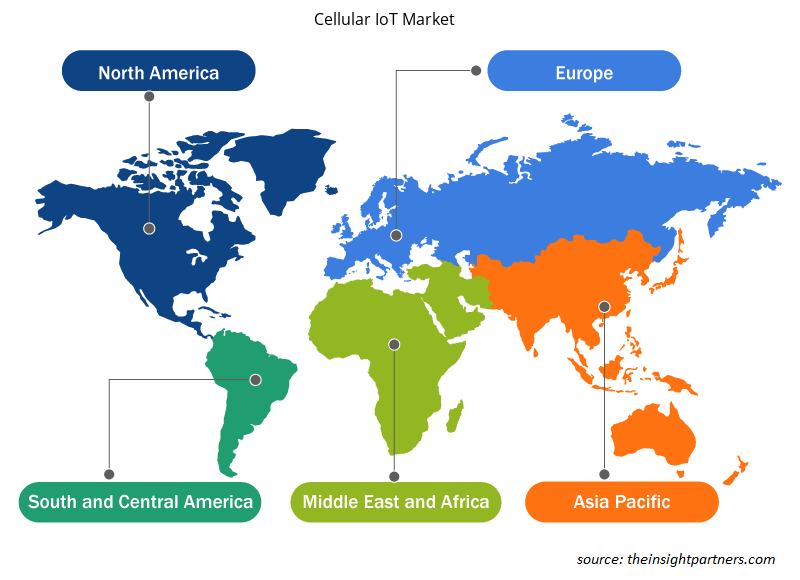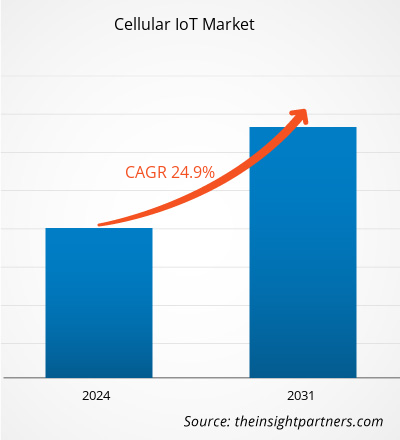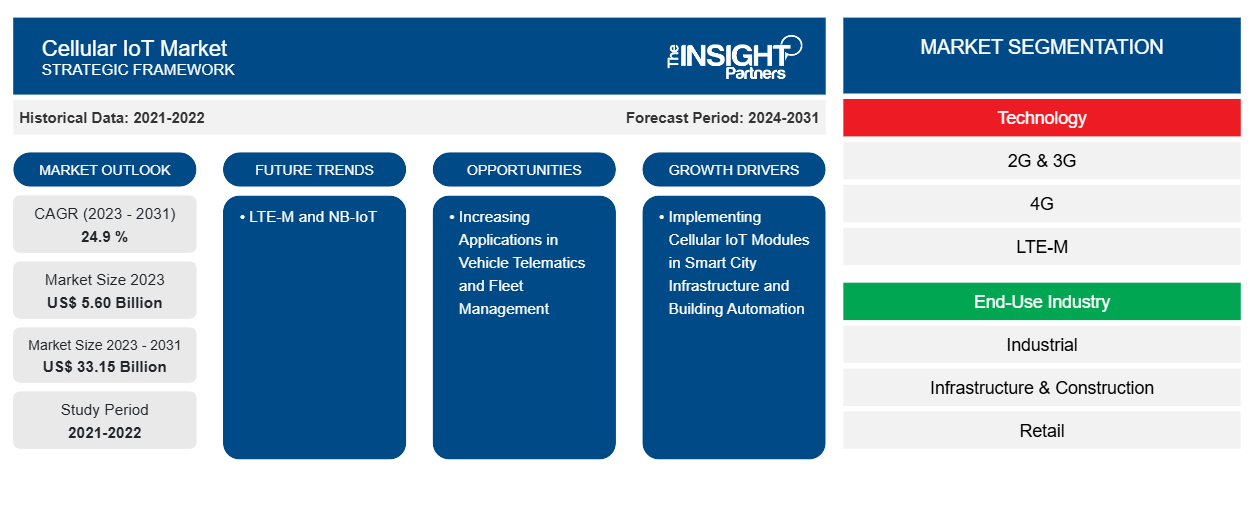Der Markt für zellulares IoT soll von 5,60 Milliarden US-Dollar im Jahr 2023 auf 33,15 Milliarden US-Dollar im Jahr 2031 anwachsen. Der Markt für zellulares IoT soll in den Jahren 2023–2031 eine durchschnittliche jährliche Wachstumsrate von 24,9 % verzeichnen. Zellulare IoT-Module werden zunehmend in der Smart-City-Infrastruktur und Gebäudeautomatisierung sowie in der Agrarautomatisierung und Umweltüberwachung eingesetzt und treiben so das Marktwachstum voran.
Marktanalyse für zellulares IoT
Cellular IoT kann die sehr sensiblen und einzigartigen Anforderungen komplizierter Anwendungen und Einstellungen sowie die grundlegenderen Anforderungen des riesigen IoT-Marktes erfüllen. Es gibt zwei Haupttypen von Cellular IoT: Long Term Evolution for Machines (LTE-M) und Narrowband Internet of Things (NB-IoT). Beispiele für NB-IoT- und LTE-M-Anwendungen sind Präzisionslandwirtschaft, Smart Cities, Verkaufsautomaten, Flottenüberwachung und andere, die alle erhebliche Aussichten auf Marktanteile im Bereich Cellular IoT bieten. Diese Anwendungen erfordern eine zuverlässige und sichere Fernkommunikation.
Marktübersicht für zellulares IoT
Die Präsenz schnell wachsender Länder, die zunehmende Akzeptanz fortschrittlicher Technologien und eine wachsende Zahl vernetzter Geräte gehören zu den Hauptgründen, die die globale Expansion des zellularen IoT vorantreiben sollen. Der globale zellulare IoT-Markt wird voraussichtlich aufgrund der zunehmenden Digitalisierung und Automatisierung in Branchen wie der Automobilindustrie, der Fertigung sowie der Energie- und Versorgungswirtschaft wachsen. Die zunehmende Nachfrage nach erweiterter Netzabdeckung, die verbesserte Neigung zur Geschäftsentwicklung über mobiles Breitband hinaus und die Notwendigkeit, eine große Anzahl vernetzter Geräte in Unternehmen weltweit unterzubringen, werden voraussichtlich die Größe des zellularen IoT-Marktes vorantreiben.
Passen Sie diesen Bericht Ihren Anforderungen an
Sie erhalten kostenlos individuelle Anpassungen an jedem Bericht, einschließlich Teilen dieses Berichts oder einer Analyse auf Länderebene, eines Excel-Datenpakets sowie tolle Angebote und Rabatte für Start-ups und Universitäten.
-
Holen Sie sich die wichtigsten Markttrends aus diesem Bericht.Dieses KOSTENLOSE Beispiel umfasst eine Datenanalyse von Markttrends bis hin zu Schätzungen und Prognosen.
Treiber und Chancen des Mobilfunk-IoT-Marktes
Implementierung zellularer IoT-Module in Smart-City-Infrastrukturen und Gebäudeautomatisierung zur Förderung des Marktes
Smart City Building und Infrastrukturautomatisierung sind die beiden wichtigsten vertikalen Einsatzbereiche für zellulare IoT-Module und machen den Großteil des Umsatzes des zellularen IoT-Marktes aus. Dank neuer zellularer IoT-Technologien wie NB-LTE-M, NB-IoT und 5G können batteriebetriebene Geräte jetzt eine Verbindung zum Internet herstellen. Diese Technologien verbinden Geräte effektiver als aktuelle 2G- und 3G-Technologien, darunter intelligentes Parken und intelligente Straßenbeleuchtung. Straßenlaternen, Verkehrssensor- und -kontrollgeräte, Müllentsorgungsgeräte und Parkraummanagementgeräte sind nur einige der vielen Einsatzmöglichkeiten für zellulares IoT in Smart Cities. Moderne Infrastrukturverbesserungen haben für Regierungen auf der ganzen Welt höchste Priorität, und um dieses Ziel zu erreichen, werden mehrere Pilotprojekte gestartet.
Zunehmende Anwendungen in Fahrzeugtelematik und Flottenmanagement
Fahrzeugtelematik ist eine der wichtigsten neuen Anwendungen für zellulares IoT, da sie Leistung und Verbindung verbessert und gleichzeitig die Ressourcen eines Unternehmens nutzt. Der Trend, Telematiksysteme in Gelände- und Straßenfahrzeugen einzusetzen, dürfte erhebliches Entwicklungspotenzial generieren. Bei Geländegeräten wie Kränen und Baggern mit einer begrenzten Anzahl an Fachkräften ist Zeit ein kritischer Faktor. Die Implementierung von IoT- und Telematiklösungen ist für die Überwachung von Geräten und Straßengütern erforderlich. Daher integrieren Anbieter von Telematiklösungen zellulare IoT-Module in ihre Produktangebote, wodurch Flottenmanager und OEMs von Geländefahrzeugen Felddaten, Trends und Probleme leichter erfassen und analysieren können.
Segmentierungsanalyse des Cellular IoT-Marktberichts
Wichtige Segmente, die zur Ableitung der Marktanalyse für zellulares IoT beigetragen haben, sind Technologie, Bereitstellung, Endverbrauchsbranche und Endbenutzer.
- Basierend auf der Technologie ist der zellulare IoT-Markt in 2G & 3G, 4G, LTE-M, NB-IoT und 5G segmentiert.
- Basierend auf der Endverbrauchsbranche ist der zellulare IoT-Markt in die Bereiche Industrie, Infrastruktur und Bau, Einzelhandel, Unterhaltungselektronik , Automobil und Transport, Energie und Versorgung, Gesundheitswesen und Sonstige segmentiert.
Cellular IoT Marktanteilsanalyse nach Geografie
Der geografische Umfang des Marktberichts zum zellularen IoT ist hauptsächlich in fünf Regionen unterteilt: Nordamerika, Asien-Pazifik, Europa, Naher Osten und Afrika sowie Südamerika/Süd- und Mittelamerika. Länder wie Indien und China haben eine große Anzahl von Halbleiterhändlern. Darüber hinaus wird erwartet, dass der wachsende Markteintritt von Technologieunternehmen in der Region sowie erhöhte Investitionen in IoT-Technologien die Marktexpansion vorantreiben werden. Regierungen in asiatischen Ländern wie Indien sind ebenfalls an der zellularen IoT-Branche interessiert und setzen eine Reihe intelligenter Infrastrukturprojekte um. Die Regierungen von Indien, Japan, China, Korea, Malaysia und Singapur haben sich für nationale zellulare IoT-Richtlinien ausgesprochen.
Regionale Einblicke in den Mobilfunk-IoT-Markt
Die regionalen Trends und Faktoren, die den Markt für zellulares IoT im Prognosezeitraum beeinflussen, wurden von den Analysten von Insight Partners ausführlich erläutert. In diesem Abschnitt werden auch die Marktsegmente und die Geografie für zellulares IoT in Nordamerika, Europa, im asiatisch-pazifischen Raum, im Nahen Osten und Afrika sowie in Süd- und Mittelamerika erörtert.

- Erhalten Sie regionale Daten zum Mobilfunk-IoT-Markt
Umfang des Marktberichts für zellulares IoT
| Berichtsattribut | Details |
|---|---|
| Marktgröße im Jahr 2023 | 5,60 Milliarden US-Dollar |
| Marktgröße bis 2031 | 33,15 Milliarden US-Dollar |
| Globale CAGR (2023 - 2031) | 24,9 % |
| Historische Daten | 2021-2022 |
| Prognosezeitraum | 2024–2031 |
| Abgedeckte Segmente |
Nach Technologie
|
| Abgedeckte Regionen und Länder |
Nordamerika
|
| Marktführer und wichtige Unternehmensprofile |
|
Dichte der Akteure auf dem Mobilfunk-IoT-Markt: Auswirkungen auf die Geschäftsdynamik verstehen
Der Markt für zellulares IoT wächst rasant, angetrieben durch die steigende Nachfrage der Endnutzer aufgrund von Faktoren wie sich entwickelnden Verbraucherpräferenzen, technologischen Fortschritten und einem größeren Bewusstsein für die Vorteile des Produkts. Mit steigender Nachfrage erweitern Unternehmen ihr Angebot, entwickeln Innovationen, um die Bedürfnisse der Verbraucher zu erfüllen, und nutzen neue Trends, was das Marktwachstum weiter ankurbelt.
Die Marktteilnehmerdichte bezieht sich auf die Verteilung der Firmen oder Unternehmen, die in einem bestimmten Markt oder einer bestimmten Branche tätig sind. Sie gibt an, wie viele Wettbewerber (Marktteilnehmer) in einem bestimmten Marktraum im Verhältnis zu seiner Größe oder seinem gesamten Marktwert präsent sind.
Die wichtigsten auf dem Cellular-IoT-Markt tätigen Unternehmen sind:
- Arm Holdings Plc
- AT&T, Inc.
- Ericsson
- Huawei Technologies Co., Ltd.
- Mediatek Inc.
- Qualcomm Incorporated
Haftungsausschluss : Die oben aufgeführten Unternehmen sind nicht in einer bestimmten Reihenfolge aufgeführt.

- Überblick über die wichtigsten Akteure auf dem Cellular-IoT-Markt
Neuigkeiten und aktuelle Entwicklungen zum Mobilfunk-IoT-Markt
Der Markt für zellulares IoT wird durch die Erhebung qualitativer und quantitativer Daten nach Primär- und Sekundärforschung bewertet, die wichtige Unternehmensveröffentlichungen, Verbandsdaten und Datenbanken umfasst. Im Folgenden finden Sie eine Liste der Entwicklungen auf dem Markt:
- Im Mai 2022 gab Audi ein Update zu seiner Zusammenarbeit mit der Mobilitätsplattform Spoke und anderen Partnern bekannt, um mithilfe der Cellular Vehicle-to-Everything (C-V2X)-Technologie Unfälle mit Fahrrädern und Autos zu minimieren. Darüber hinaus arbeitete Audi mit C-V2X zusammen, das LTE-Mobilfunksignale und direkte PC5-Signale verwendet, die kein Mobilfunknetz benötigen, um einen Radfahrer zu erkennen.
(Quelle: Audi, Pressemitteilung, 2022)
- Im Januar 2023 kündigte Sierra Wireless die Einführung von Smart Connectivity Premium in den USA an, das eUICC-Funktionen und eine erweiterte Konnektivitätsabdeckung umfasst. Darüber hinaus bietet Smart Connection Premium mit seinem Multi-IMSI- und Multi-Profile-Design, das durch die GSMA eSIM (eUICC)-Anforderungen unterstützt wird, eine robuste, IoT-verwaltete Verbindung, die über Länder und Technologien hinweg mit einer einzigen globalen SIM zukunftssicher ist.
(Quelle: Sierra Wireless, Pressemitteilung, 2023)
Marktbericht zum zellularen IoT: Abdeckung und Ergebnisse
Der Bericht „Cellular IoT Market Size and Forecast (2021–2031)“ bietet eine detaillierte Analyse des Marktes, die die folgenden Bereiche abdeckt:
- Marktgröße und Prognose auf globaler, regionaler und Länderebene für alle wichtigen Marktsegmente, die im Rahmen des Projekts abgedeckt sind
- Marktdynamik wie Treiber, Beschränkungen und wichtige Chancen
- Wichtige Zukunftstrends
- Detaillierte PEST/Porters Five Forces- und SWOT-Analyse
- Globale und regionale Marktanalyse mit wichtigen Markttrends, wichtigen Akteuren, Vorschriften und aktuellen Marktentwicklungen
- Branchenlandschaft und Wettbewerbsanalyse, einschließlich Marktkonzentration, Heatmap-Analyse, prominenten Akteuren und aktuellen Entwicklungen
- Detaillierte Firmenprofile
- Historische Analyse (2 Jahre), Basisjahr, Prognose (7 Jahre) mit CAGR
- PEST- und SWOT-Analyse
- Marktgröße Wert/Volumen – Global, Regional, Land
- Branchen- und Wettbewerbslandschaft
- Excel-Datensatz
Aktuelle Berichte
Verwandte Berichte
Erfahrungsberichte
Grund zum Kauf
- Fundierte Entscheidungsfindung
- Marktdynamik verstehen
- Wettbewerbsanalyse
- Kundeneinblicke
- Marktprognosen
- Risikominimierung
- Strategische Planung
- Investitionsbegründung
- Identifizierung neuer Märkte
- Verbesserung von Marketingstrategien
- Steigerung der Betriebseffizienz
- Anpassung an regulatorische Trends























 Kostenlose Probe anfordern für - Markt für zellulares IoT
Kostenlose Probe anfordern für - Markt für zellulares IoT